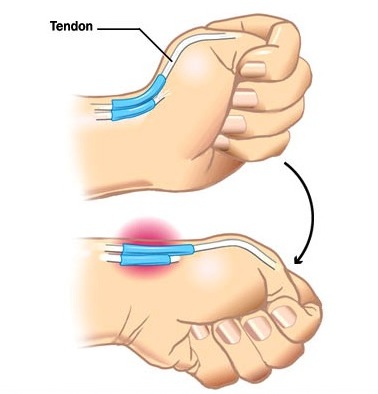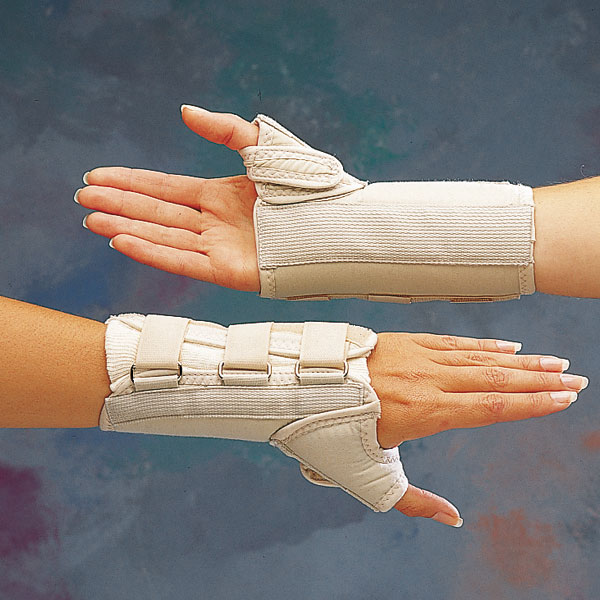DeQuervains Tenosynovitis
DeQuervains Tenosynovitis is a painful condition affecting the tendons on the thumb side of your wrist. The specific tendons involved are Extensor Pollicis Longus and Abductor Pollicis Brevis. It is called tenosynovitis as the synovial sheath around the tendons becomes thickened or inflamed causing the tendons to get stuck or catch as they attempt to move through the sheath. It is characterized by pain when you turn your wrist, grasp or lift, particularly with the thumb pointing upwards.
Causes
The condition is more common in women than in men. It is often associated with pregnancy. Baby care, including lifting a baby many times a day, can make the condition worse. There are a wide range of causes including but not limited to the following:
- Any activity that relies on repetitive hand or wrist movement, such as working in the garden, playing golf or lifting a baby.
- Direct injury to your wrist or tendon. This can create inflammation or scar tissue which can restrict movement of the tendons.
- Inflammatory arthritis, such as rheumatoid arthritis
Symptoms
One of the tests use by doctors and Hand Therapists to diagnose DeQuervains Tenosynovitis is called the Finkelsteins test. It involves clasping the thumb in a gentle fist and bending the wrist forward, as if you were slowly hammering. Then, the area highlighted in the picture is pressed. In a positive test there is sharp, disproportionate pain. Imaging tests, such as X-rays, generally aren’t needed to diagnose DeQuervains Tenosynovitis. The main symptoms are as follows:
- Pain to the base of the thumb where it intersects with the wrist over a landmark called the Anatomical Snuff Box.
- Swelling near the base of your thumb
- Difficulty moving your thumb and wrist when doing activities that involve grasping or pinching
- A sticking or catching sensation in the back of your thumb when you try to move it
If the condition continues without treatment, the pain may become more generalized and radiate up your thumb, back into your forearm or both. Pinching, grasping and other movements of your thumb and wrist aggravate the pain.
Treatment
Treatment for DeQuervains Tenosynovitis may include medications, Hand Therapy, or surgery. Treatment is generally more successful if begun early on, though the pain may recur if you can’t discontinue the repetitive motions or activity that aggravate your condition. If treatment is started early on, symptoms of DeQuervains may improve or completely resolve within four to six weeks. When DeQuervains starts during pregnancy, symptoms usually get better around the end of pregnancy or when breast-feeding stops.
Therapy
- Therapy usually begins with the provision of a custom or off the shelf splint that immobilizes the wrist and thumb.
- Icing the affected area several times throughout the day
- Avoiding all activity and movement that creates pain
- Your Hand Therapist will also teach you exercises focused on your wrist, hand and arm to strengthen your muscles, reduce pain, and limit the irritation of the tendons.
- Several modalities can offer some relief when used in conjunction with the approaches listed able. These include ultrasound, phonophoresis and cold laser.
Medications
To reduce pain and swelling a physician may recommend using NSAIDs, such as ibuprofen and naproxen. They may also recommend injections of corticosteroid medications into the tendon sheath to reduce swelling. The results of this treatment vary from patient to patient with some obtaining full relief, some incomplete or temporary and some no benefit at all.
Surgery
If the condition is more chronic or has been going on for several months or more your physician may recommend surgery. Surgery involves a procedure in which your surgeon opens the sheath to release the pressure and restore free tendon gliding. It is usually done in an outpatient facility and can effectively restore pain free function. Therapy may be required afterwards as there is sometimes irritation of a sensory nerve close to the tendons that can cause hypersensitivity to the skin. There also may be adhesions, loss of motion and strength that can be helped with Hand Therapy.
If you have any questions about DeQuervains Tenosynovitis or anything related to Hand Therapy please feel free to contact us.












